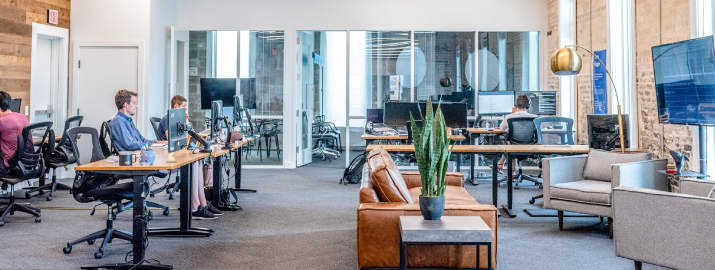
Employee Experience: What It Is and How to Improve It
Table of Contents
Have you ever heard of the term ‘employee experience’? Although it sounds broad, it is nothing more than the overall experience of the employee of a company.
A company is made up of several elements, one of the most important being the employee.
Generally, the employee stands at the front, in direct contact with the customer and with the collaborators, representing the company’s institutional image.
Despite such importance, unfortunately, many companies do not invest in the positive experience of their employees. On the contrary, they encourage an outdated setup, with only top-down communication, low wages, and minimal professional appreciation, with little attention paid to the comfort of the work environment.
Consequently, there is a high turnover of employees, which is negative for the corporate image, as well as for income and prominence within the labor market.
Keeping the employee experience at a high standard is even more challenging in today’s remote work environment.
In this article, we will expand on how to improve the employee experience of a business, and, consequently, the development of the team and the business as a whole.
Don’t miss out on the list of 10 actionable items at the bottom of the article. Let’s go!
Employee experience: Why Is It Important?
Investing in a good work environment, paying a competitive salary, and expressing professional appreciation lead to better results in sales. Not only that, but it also improves the image of the company to the target audience.
Basically, when we talk about employee experience, we are not referring to a friendly relationship. Rather, we refer to encouraging a transparent and positive climate and presenting the employees with opportunities in the workplace.
Thus, we are referring to a well-structured workplace, a leadership that is attentive and that knows how to listen and stimulate development. This also means the management knows how to align relevant benefits for the employee.
Employee experience can also be improved and optimized by investing in training and technical qualification. This immediately makes the climate within the organization better and demonstrates that there is an exchange of values between the institution and the employee.
The employee journey has a lot to do with the organization’s culture, as well as its mission, vision, and values.
Therefore, if you want to convey a positive image of your organization and be considered innovative, attracting people interested in working there is key.
How To Improve Your Employee Experience?
In terms of marketing, there are some elements that we need to take into account: internal marketing and internal communication.
These are two important strategies for anyone who wants to improve the employee experience.
Internal marketing refers to the set of actions directed to the employee, as well as to people who are close to the company, such as outsourced workers and resellers. This strategy has the following benefits:
- Employee motivation;
- The improved climate within the organization;
- Lower turnover rate ;
- Increase in productivity, whether in sales or services.
When we talk about internal communication, we also refer to a strategy that is known as attraction marketing or inbound marketing, which should not only be applied in sales processes with the customer but also so that it is possible to have a qualified approach with the employee, highlighting the culture and aligning communication.
For this, it is important to develop actions such as:
- Create an internal newsletter or journal;
- Count on an application for employee integration;
- Promote team activities and talk with the head to hear suggestions;
- Have efficient internal communication channels.
It is important to understand how internal marketing and internal communication can be applied to obtain an improvement within the organizational environment, as well as in the employee’s experience.
Applying the Techniques
To have a good line of communication within the company, it is important to pay attention to the type of content that will be developed.
Therefore, one of the tips is to produce newsletters based on whatever the company focuses on. This also entails creating actions to stimulate, engage, and develop the team, leading to a fruitful internal interaction.
In terms of materials and information, it is essential to develop material that is relevant, attractive, and enlightening for the workforce, reinforcing the culture.
It is very important that this is a two-way street, that is, the employee also has space to communicate and express opinions.
Some companies choose to create an application that allows this contact, while others choose informal networks, such as WhatsApp or Slack groups, in addition to reinforcing communication and opening up to feedback.
To reach new talent and customers with actions carried out for the internal public, it is possible to advertise on social networks. The usual suspects are Facebook Ads, Twitter Ads, and of course Google Ads.
List of Actions to Improve Employee Experience
Now, let’s dig into a list of 10 actions that can help improve the employee experience in your organization.
- Actively Listen to Employees
Organizations have to actively listen to their employees, to learn about their expectations, interests, perceptions, and needs. The understanding of all these “emotional” and experience-generating aspects will bring a series of concrete benefits for companies, such as a higher quality of talent, an improvement in development opportunities, etc.
Maciek Kubiak, head of people at PhotoAiD, believes that communication is the key. Employers make sure that they keep the lines of communication open between themselves and their remote employees. This will help them feel like they are part of the team and not just an afterthought.
- Involve Employees in the Design and Development Stages
Human Resources (HR) must involve employees in the design of all their actions, think “with” and not “for” them, getting rid of the paternalistic role that HR typically takes. It would be useful to leave the office and “get down on the stage”. HR should know the business, define the targets for employees, define what their moments of truth are, and establish their journey within the organization.
- Make Managers Take Active Roles
The saying “your boss is your company” is truer than ever. Managers and leaders have great influence over the employees. They represent the company and what it stands for in the eye of the employees; they take a leading role in creating pleasant work environments for their teams. This, in turn, helps the company achieve its objectives and improve employee engagement. The relationship and coordination of managers with HR are essential to be able to carry out a better experience for all employees.
- Focus on Agility and Flexibility
HR must take a qualitative leap to swiftly adapt to all the changes that organizations face today. However, paradoxically, achieving this agility is often complicated, taking into account the large number of regulatory elements to which the HR function is subject.
- Flourish Employee Relationships in All Phases
It is very important to analyze and take care of the professional’s experiences throughout their cycle of relationship with the company. Not only during their time as an employee, but also in the previous stage as a candidate, and later as a former employee of the organization. Processes such as “onboarding” taking place prior to joining the company, or “disengagement”, are gaining more and more prominence in the current context.
- Design Personalized Talent Plans Adapted to Each Professional
Just like companies do with their clients, HR has to win over employees who demand personalized “needs” adapted to their needs. It’s necessary to define the target “Employee Persona” of the different groups of professionals and generate special recognitions in order to have happy employees committed to their organizations. When designing these experiences/products, we will have to take into account that in many cases it is not a matter of large economic investments, but of company culture. Generating flexible environments, fostering learning and professional opportunities, or giving employees the freedom to make decisions are some of the examples that we can implement to generate these pleasant experiences.
- Use Technology whenever Possible
In the era of digitization, technology has become a necessary vehicle that provides us with that much-needed agility and speed to successfully overcome the current challenges facing our organizations. In addition, these technological solutions will give us the ability to collect information, analyze it and customize it according to the needs of each employee.
- Encourage Innovation
The use of agile methodologies, such as ‘Design Thinking’ encourage innovation in companies to generate differentiating products and services adapted to the needs of current customers. The application of this method in HR offers enormous potential to improve employee satisfaction, commitment, and performance.
- Implement New Business Strategies
The digital transformation of the labor market, the incorporation of new generations, or globalization, has led to the appearance of new business strategies to cater to these needs. The appearance of “Smart Working”, a formula for the evolution of “Teleworking” with the incorporation of concepts of mobility, work by objectives, and use of technology, seeks to provide flexibility and empower employees in decision-making and improve the branding as an employer, by valuing all the benefits of the organization.
- Use Marketing as a Reference
Marketing offers many benefits through the use of processes, methodologies, and tools previously obtained to attract customers in helping to understand, personalize, and improve the employee experience.
Make sure to add any additional tips you may have in the comments. And if you found this article useful, we encourage you to check out other articles on HappySoundsLike.

